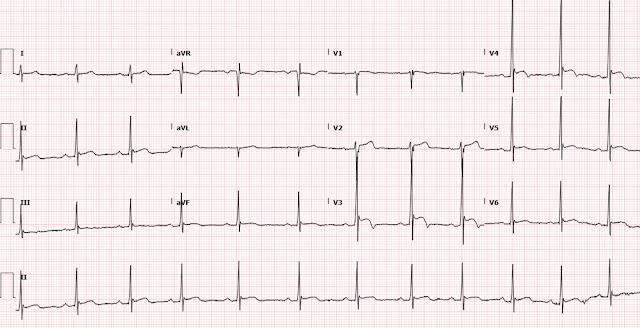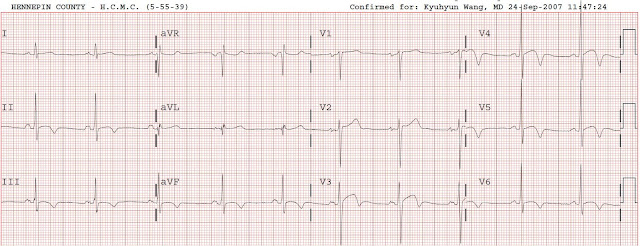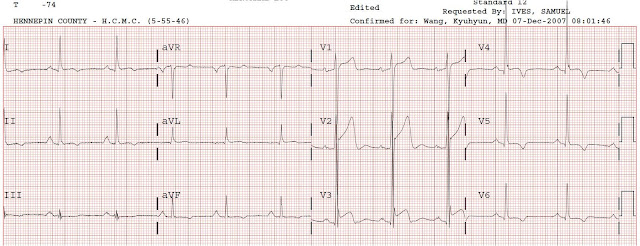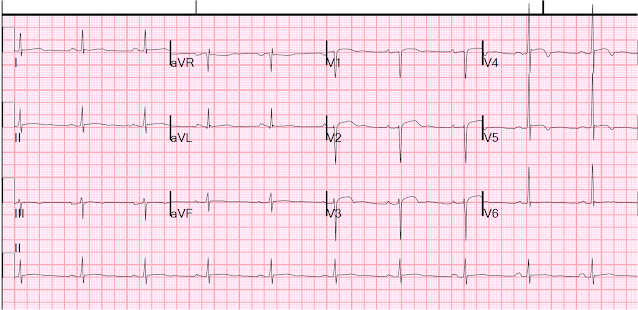Written by Pendell Meyers
Interpret this ECG first without context. You don't need context yet because this ECG is nearly pathognomonic.
After having learned about benign T wave inversion pattern years ago on this blog, and having seen many cases on this blog and in my practice since then, I instantly recognize this as BTWI, a fairly common normal variant. I see maybe one of these ECGs each month in my practice. There is no ischemia, certainly no concern at all for OMI.
It meets basically all of the criteria that Dr. Smith has consistently described over the years, after reviewing a large cohort of patients by Wang et al. (see below for more info on this)
1. There is a relatively short QT interval (QTc < 425ms)
2. The leads with T-wave inversion often have very distinct J-waves.
3. The T-wave inversion is usually in leads V3-V6 (in contrast to Wellens' syndrome, in which they are V2-V4)
4. The T-wave inversion does not evolve and is generally stable over time (in contrast to Wellens', which always evolves). (you'll see that this case does not evolve like Wellens)
5. The leads with T-wave inversion (left precordial) usually have some ST elevation
6. Right precordial leads often have ST elevation typical of classic early repolarization
7. The T-wave inversion in leads V4-V6 is preceded by minimal S-waves
8. The T-wave inversion in leads V4-V6 is preceded by high R-wave amplitude
9. II, III, and aVF also frequently have T-wave inversion. (lead aVF has minimal terminal T wave inversion in this case)
Now watch what may happen if you haven't learned about BTWI:
A Black teenager (we don't usually specify Black or white, etc., but in this case it is important) with type 1 diabetes presented to the ED for chest pain. He had experienced sudden onset sharp, nonradiating substernal chest pain associated with shortness of breath, 5/10 intensity.
This ECG (the one from above) was his ECG on initial evaluation:
He had a baseline ECG available on file:
Baseline 1 year ago:
 |
| Baseline is normal. All normal variants of which I am aware can come and go, change over time. |
The ECG was interpreted as STEMI.
He received aspirin, heparin, nitroglycerin, and was emergently transferred to a cath lab center where he was cathed immediately on arrival. "We proceeded to emergent cardiac catheterization given the abnormal EKG, chest pain, and type 1 diabetes mellitus."
The angiogram was normal.
The formal echo was normal.
Serial ECGs during admission were unchanged.
Troponins were undetectable.
Inflammatory markers were sent at this point, which were normal.
It seems like his symptoms resolved at some point.
He was finally sent home.
Two weeks later he was seen in cardiology clinic for follow up.
Here was his ECG at that time:
Two years prior to this event, there was a sports physical note in his chart:
"Presented today with parents for sports physical to do track....a routine EKG was performed. Despite frequent readjustments of the leads and repeated runs, all of the tests showed NSR, but possible LVH, possible pericarditis and ST elevation. It is our protocol to refer to cardiology to obtain sports clearance in these cases. Note given for PE that he can walk laps, but to avoid physical exertion at this time until cardiac evaluation is completed."
For some reason, this patient seems to have yearly cardiology follow up visits.
BTWI is a normal variant associated with early repolarization. K. Wang studied it. He reviewed ECGs from all 11,424 patients who had at least one recorded during 2007 at Hennepin County Medical Center and set aside the 101 cases of benign T-wave inversion. 97 were Black. 3.7% of Black men and 1% of Black women had this finding. 1 of 5099 white patients had it. Aside from an 8.8% incidence (9 of 109) black males aged 17-19, it was evenly distributed by age group.
Dr. Smith reviewed these 101 ECGs, and described the key findings of the pattern:
1. There is a relatively short QT interval (QTc < 425ms)
2. The leads with T-wave inversion often have very distinct J-waves.
3. The T-wave inversion is usually in leads V3-V6 (in contrast to Wellens' syndrome, in which they are V2-V4)
4. The T-wave inversion does not evolve and is generally stable over time (in contrast to Wellens', which always evolves).
5. The leads with T-wave inversion (left precordial) usually have some ST elevation
6. Right precordial leads often have ST elevation typical of classic early repolarization
7. The T-wave inversion in leads V4-V6 is preceded by minimal S-waves
8. The T-wave inversion in leads V4-V6 is preceded by high R-wave amplitude
9. II, III, and aVF also frequently have T-wave inversion.
Next you will see many cases of BTWI, in all its flavors:
IMPORTANT: you must be able to differentiate OMI's reperfusion pattern from BTWI.
They are different in many ways which are difficult to describe in words. Obviously the patients are quite different in terms of clinical history, presence of active symptoms during the T wave inversions, eventual troponin elevation, etc., but the ECGs are also different.
See if you can differentiate these cases, answers below:
 |
| BTWI. This as a 20 yo man presenting with resolved chest pain. |
 |
LVH. This patient had acute aortic dissection, which has nothing to do with his chronic LVH ECG. Is it important to recognize LVH Pseudo-infarction patterns? |
Learning Points:
Learning the normal variant patterns of ECGs is nearly as important as learning the OMI patterns, and equally achievable if you are willing to learn past the STEMI paradigm.
Normal variants can change over time.
Not all T wave inversion is Wellens. There are many important mimics including LVH and BTWI. You can sort them out with practice.
BTWI is a normal variant associated with early repolarization, most commonly seen in young Black men.
See these cases of BTWI for the images above:
A 60-something male presents with crushing chest pain
15 yo AAM with ST Elevation and T-wave Inversion. Hypertrophic Cardiomyopathy or Normal ("Variant")?
T-wave inversions and dynamic ST elevation
MY Comment by KEN GRAUER, MD (3/22/2022):
===================================
I found this post by Dr. Meyers essential for emphasizing KEY patterns of T-Wave Inversion (TWI ) and Early Repolzariation (ER) — that are likely to be benign. I'll limit my comments to a additional points brought out by the initial case from today.
POINT #1: The History
- While I completely agree with Dr. Meyers that clinicians should be able to immediately recognize without clinical context the very high probability of a benign prognosis attached to the initial tracing in today's case — the History is important.
- Clearly, this initial ECG ( = ECG #1, which I have reproduced in Figure-1) — satisfies virtually all 9 criteria put forth by Drs. Wang and Smith (as noted above by Dr. Meyers). I also immediately thought this was most likey a benign variant.
- That said, in my experience of overreading numerous in-patient and out-patient ECGs over the years — the History is all-too-often ignored. For example — IF the history in today's case associated with ECG #1 was syncope of unknown etiology — and — the patient's Family History revealed a number of close relatives with sudden death at an early age — then despite the benign appearance of ECG #1 — further evaluation of this patient would definitely be indicated.
- After all — ECG #1 is remarkable not only for its T wave inversion in leads V2,V3 — but also for its resemblance to an Early Repolarization pattern, with prominent J-point notching in multiple leads associated with upward concavity ST elevation in multiple leads (attaining >2 mm in lead V3). And, as I'll highlight momentarily — in a later ECG from this patient (ie, ECG #4 — in Figure-2) — there was no T wave inversion at all (only J-point notching with concave-up ST elevation in multiple leads). Clearly — there is overlap between the syndromes of BTWI and ER.
- These last 2 bullets are relevant to clinicians in emergency care — because ER patterns of varying degree are more common than BTWI. Although the overwhelming majority of young adults presenting for emergency care who manifest ER patterns on ECG have a benign prognosis — there is a small-but-present percentage of such individuals who go on to develop a lethal cardiac arrhythmic event (Zakka & Refaat- ACC, 2016).
- BOTTOM Line: Great point by Dr. Meyers to emphasize the strong likelihood of a benign prognosis associated with tracings like ECG #1 in Figure-1. But eliciting both a personal and family History on such patients (inquiring about syncope-presyncope, or malignant arrhythmia symptoms) — is essential for optimal management.
- P.S.: Note that in today's case — the brief description of the chest pain history in this teenager does not sound convincing for an acute cardiac event. Given this low prevalence likelihood for an acute cardiac event — an extensive hospitalization and evaluation could have been avoided had the treating clinicians appreciated the importance of considering the clinical History of this teenager.
-USE.png) |
| Figure-1: Comparison of the initial ECG in today's case — with a baseline ECG obtained 1 year earlier (See text). |
- Greenfield and Rembert have noted that up to 1/3 of patients with ER but no cardiac symptoms — may show marked variation in the amount of ST elevation from one tracing to the next. These ER patients did not have ischemia — and the variation in ST elevation was not related to either heart rate or QRS amplitudes (Variation in ST-Segment Elevation in Early Repolarization: Electrocardiography 40:10,2007).
- Aagaard et al commented on the effect of parasympathetic tone on development and persistence ST-T wave changes with ER (Circulation 9: e003577, 2016). ST-T wave findings of ER are more common in trained athletes — and these ECG findings decrease (and may disappear) in many athletes once they stop their athletic endeavors.
- We've noted similar potential on occasion (not common) — for ST-T wave changes of ER over a period of several hours as serial ECGs are being obtained (See the July 24, 2013 post, among others — in Dr. Smith's ECG Blog).
- PEARL #1: Appreciation of this potential for variation in ST-T wave changes of ER (and/or TWI) is essential — because while this is not common, it does highlight that even in patients with benign repolarization variants — some serial ST-T wave changes may be seen!
- Did YOU note the marked difference between the initial ECG in today's case — compared to a baseline tracing done 1 year earlier? (ECG #1 vs ECG #2 in Figure-1). Both tracings show excellent R wave progression and increased QRS amplitude — but J-point notching and the amount of ST elevation has clearly increased since the baseline tracing was done — and — the above-mentioned T wave inversion is now present in leads V3,V4 of ECG #2.
- PEARL #2: Did YOU note the unusual notching just after the T wave in leads V2 and V3 of ECG #2? (WHITE arrows in ECG #2 — compared to the RED arrow sinus P waves). This is another interesting normal variant pattern that we commented on in the July 10, 2021 post of Dr. Smith's ECG Blog (it is most often seen in younger children — but today's case demonstrates that it may also be seen in teenagers).
-USE.png) |
| Figure-2: Comparison of the initial ECG in today's case — with follow-up ECGs done 2 weeks and 4 weeks later (See text). |
- Some of these ST-T wave differences can be attributed to differences in chest lead electrode placement. That said — I do not think all ST-T wave differences are the result of the difference in R wave progression!
- Not only has the location of T wave inversion moved laterally from ECG #1 to ECG #3 — but the shape of the ST segments has changed! Note how the ST elevation in leads V2,V3 of ECG #1 is upward-sloping, and associated with prominent J waves. In contrast — the ST elevation in leads V4,V5 in ECG #3 is coved and no longer associated with J-point notching. Viewed by itself — I would not be at all convinced that the ECG picture in ECG #3 was benign!
- 2 weeks later — ECG #4 was obtained. Given this sequence of events — I thought it likely that return of J-point notching with associated ST elevation in multiple leads signaled evolution toward once again (perhaps within a few more weeks) returning to the ER/TWI pattern seen in ECG #1. But note that there is not yet any T wave inversion in ECG #4.
- Final PEARL #3: Equally important as recognizing high likelihood of the benign ECG pattern shown in ECG #1 — is appreciation that on occasion, there may be even marked variation (over shorter or longer time periods) with the otherwise benign ST-T wave pattern of ER/TWI.






















No comments:
Post a Comment
DEAR READER: I have loved receiving your comments, but I am no longer able to moderate them. Since the vast majority are SPAM, I need to moderate them all. Therefore, comments will rarely be published any more. So Sorry.